All AbMole products are for research use only, cannot be used for human consumption.

ML133 hydrochloride is a potent K(ir)2.1 inhibitor, which inhibits K(ir)2.1 with an IC50 of 1.8 μM at pH 7.4 and 290 nM at pH 8.5 but exhibits little selectivity against other members of Kir2.x family channels. ML133 hydrochloride has no effect on K(ir)1.1 (IC50 > 300 μM) and displays weak activity for K(ir)4.1 (76 μM) and K(ir)7.1 (33 μM). ML133 HCl also displays modest selectivity versus hERG and possesses fair ancillary pharmacology against a larger panel of GPCRs, ion channels and transporters.

Journal of Oral Science Research. 2025 May 24;(5): 413-419.
Effect of Membrane Potential on Osteogenic Differentiation of Human Dental Follicle Stem Cells and Its Electrophysiological Mechanisms
ML133 hydrochloride purchased from AbMole

Hua Xi Kou Qiang Yi Xue Za Zhi. 2022 Apr;40(2): 139–147.
Effect of inward rectifier potassium 2.1 channel on the osteogenic differentiation of human dental follicle cells and its mechanism
ML133 hydrochloride purchased from AbMole
| Molecular Weight | 313.82 |
| Formula | C19H19NO.HCl |
| CAS Number | 1222781-70-5 |
| Solubility (25°C) | DMSO 48 mg/mL |
| Storage |
Powder -20°C 3 years ; 4°C 2 years In solvent -80°C 6 months ; -20°C 1 month |
| Related Potassium Channel Products |
|---|
| VU0810464
VU0810464 is a potent and selective non-ureaG protein-gated inwardly-rectifying potassium channels (GIRK, Kir3) activator. VU0810464 displays nanomolar potency for neuronal (EC50=165 nM) and GIRK1/4 (EC50=720 nM) channels with improved brain penetration. |
| QO 58
QO 58 is a potent modulator of K(v)7 channels. |
| NS3623
NS3623 is an activator of human ether-a-go-go-related gene (hERG1/KV11.1) potassium channels. |
| ML67-33
ML67-33 is a selective activator of temperature- and mechano-sensitive K2P channels. |
| A-935142
A-935142 is a human ether-a-go-go-related gene (hERG, Kv 11.1) channel activator. |
All AbMole products are for research use only, cannot be used for human consumption or veterinary use. We do not provide products or services to individuals. Please comply with the intended use and do not use AbMole products for any other purpose.


Products are for research use only. Not for human use. We do not sell to patients.
© Copyright 2010-2024 AbMole BioScience. All Rights Reserved.
